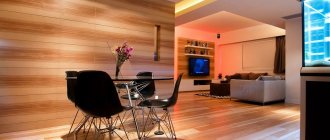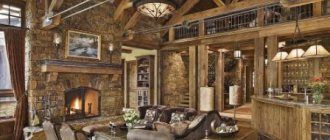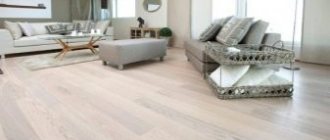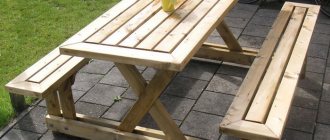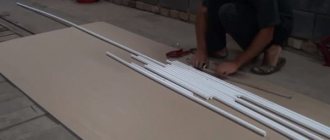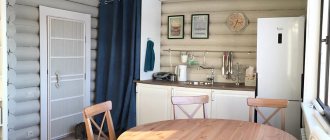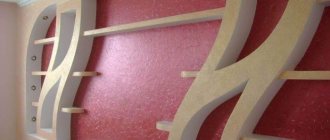Decorating doorways with decorative stone - step-by-step instructions
There is an opinion that this method of designing openings is not suitable for residential premises. However, many experts recommend in some cases finishing the door jamb with decorative stone. A detailed examination of this technology leads to the idea: this type of framing allows you to realize original design ideas, and with your own hands.
The feasibility of using decorative stone is determined on site; it depends on many factors - the overall interior, the appearance of the door installed in the opening, its geometry and others. But in some cases this material is simply irreplaceable.
- For decorating openings in large, spacious rooms. As an option - small, but with a minimum of furniture.
- If the walls in the area of the door jamb have significant, difficult-to-remove defects, decorative stone perfectly masks them.
- In cases where this finishing material is an integral part of the decor. For example, if the room is stylized as antique.
There are two types of decorative stones on sale – natural and artificial. The former are not used so often in the interior of residential premises due to the high cost and complexity of the cladding; they are characterized by heavy weight. And this includes the load on the ceiling and certain difficulties in fixing the samples on the jamb. The tiles are an imitation of natural analogues; moreover, they do not contain “chemistry” (or its concentration is negligible and is not taken into account). The raw materials are crushed rocks; Dyes are added to the mixture prepared for molding to give the desired shade. To reduce the weight of samples and increase fracture strength, some manufacturers add granular polymers.
Advantages of artificial stone
- A variety of shapes, shades, textures of decorative slab products.
- Easy to attach. The imitation of natural material is characterized by correct geometry, low weight and is easy to cut, which makes it easier to fit fragments when finishing door jambs.
- Increased sample strength and resistance to abrasion.
- Inertness to climatic factors and aggressive chemical compounds. Consequently, finishing doors with decorative stone can be done in any room, regardless of its specifics. Even in those where there are sharp changes in humidity/temperature and their high/low values.
- Convenience of choice. All artificial stones differ in standard sizes and thickness. In addition, they have smooth edges, and this makes it easier to calculate the required number of products for finishing a specific area.
- Consistency of color over time. The dye introduced at the stage of preparing the mixture is evenly distributed throughout the entire structure of the material.
- Decorative stone does not burn and does not block the base; it “breathes”, which has a beneficial effect on the microclimate of the room.
- Good maintainability of the jamb lining.
Features of choice
- The color must contain at least two shades. The uniformity of color neutralizes the naturalness of the decorative stone. It is immediately clear that this is just an imitation, and not the most successful one.
- Edges. The front surface is free of large fractions, dye clots, stains and stains. On the back side, the base should not be perfectly smooth - this will reduce the quality of adhesion of the decorative stone to the door jamb; or rough, or with notches (grooves).
- Sample edges. You need to decide on the type of seam between the stones. If it is chosen to be even along its entire length, then chips of up to 2 mm are allowed. Some owners prefer to lay masonry with a visible seam; in this case, edge defects can be more significant - up to 6 mm.
- Surface treatment level. First of all, this relates to the moisture resistance of decorative stone. If there is no protective layer, it is better not to purchase; independent application, and high-quality one, is a complex process that requires practical experience.
Basic rules for decorating jambs with stone
- Symmetry. Both sides of the opening, regardless of whether there is a door jamb in it or it is dismantled, are finished identically. Only this approach will ensure the completeness of the composition.
- Height proportions. Priority is given to the bottom of the door. This applies not only to the vertical, but also to the horizontal axis. That is, the base of the opening, with any method of its design, should visually look more massive. In accordance with this, a scheme for decorating the jamb is drawn up, taking into account the size of the purchased samples.
- A combination of texture and seams. The task of a master working with artificial stone is to achieve complete naturalness of the cladding. Experts recommend that before starting installation, lay out the “picture” on the floor and evaluate the effect it gives. How to position the products relative to each other, with what interval or offset - all such nuances are calculated in advance.
- Compliance with the jamb material. This must be taken into account even before purchasing decorative products. If the door frame and slopes are well polished and varnished, then stones with a smooth front surface are used to decorate the opening. And it is advisable to attach textured samples around a jamb that is untreated (made independently) or with a “rough” wood pattern.
The procedure for designing the opening
Decorating the slopes of the front door with decorative stone is done using the same technique as the interior door. The only difference is in the choice of material - not every imitation is suitable for these purposes.
Preparing the base
- The excess is removed - old paint, plaster, and in some cases the door is also dismantled if an arched opening is planned. The task is to achieve a flat and durable surface on which the tiles will adhere securely.
- Marking the wall according to the diagram for fastening the stones.
- Applying notches (grooves) to the base. This increases its adhesion to the cladding.
- Treat all segments to be finished with a primer. The goal is the same; Plus, this composition prevents the absorption of moisture by the wall material.
- After drying, it is advisable to apply concrete contact to the base. This product will further increase the level of adhesion, which means that the fixation of the stone will be as reliable as possible.
Door jamb trim
- The tiles are laid out on the floor according to the diagram. This will make further installation easier and will allow you to once again evaluate the correctness of the choice of location of the fragments.
- Removing the baseboard. The stone is laid to the floor, and therefore the lower molding will be a hindrance; Upon completion of the work, it is easy to return it to its place.
- Determination of the horizon line. Task: to ensure that all seams are located in this plane. Using a level and a long strip, a line is drawn on the wall that corresponds to the lower cut of the stones of the first row.
- Fastening the tiles. Cladding work always starts from the corner. To fix the samples, adhesives recommended by the manufacturer are used (tile, “liquid nails”).
The nuances of the work depend on the design intent. During the finishing process, stones will have to be cut, edges polished, and bevels made; but these are details that are not of fundamental importance. If platbands are installed later, then indentations are made for them.
- Finishing the joint
To make the stone more natural, it is advisable to spray the prepared composition over the entire area of the cladding, as well as adjacent areas of the wall: acrylic varnish + tinting paste. The mixture is diluted with water to the desired consistency and applied to the surface. It is not difficult to choose a recipe.
Decorating a jamb with decorative artificial stone does not require professional training. But if this option is unacceptable for some reason, you can use materials that successfully imitate such a finish. There is a large assortment of polymer texture panels on the market, special wallpaper of the appropriate texture; working with them is much easier, as well as updating (reinstalling) damaged samples. But still, they are not able to completely replace decorative tiles. This design solution can be considered the most preferable.
Finishing the entrance door and slopes
Decorative stone is not only a high-quality facing material with a long service life, but also an attractive design element. That is why decorative stone around the door is being used more and more often. In addition to the aesthetic component, this type of finishing performs the important function of protecting corners and slopes from deformation. Modern production technologies make it possible to produce artificial stone of various textures and colors that can fit into any interior. A decorative stone at the front door will help diversify the design of the hallway, soft shades will create a summer atmosphere and remind you of a trip to warm countries, with the help of dark colors you can bring to life the style of a medieval castle, etc. Slopes lined with artificial stone not only look beautiful, they are also very practical.
The correct choice of material will not only visually expand the doorway, but also give the interior restraint and solidity. +7 or +7 from 7.00 to 00.00 Moscow time.
Features of working with stone
Facing with a decorative coating makes the doorway an original design. But when working with stone, you should follow a number of rules that will make the surface safe and stylish. For example, the material must be laid out in such a way that the protruding side of the stones does not cause injury.
Finishing rules
Finishing with artificial stone must comply with generally accepted requirements. Main rules:
- Uniform covering of the entire surface with material. It is not advisable to make the upper part of the structure more massive than the base.
- Masonry work is carried out taking into account the characteristics of the opening surface.
- The relief pattern should be positioned symmetrically.
- When laying, the stone is pressed so that the glue comes out. Excess composition is immediately removed.
- Decorative stones of different sizes are placed in a chaotic manner. This creates the most spectacular surface.
The optimal temperature for installation work is from +5 to +30ºС. If the weather is hot with temperatures above +30ºС, then half an hour before masonry work, the back side of the stone is wetted with water.
The best harmony is achieved when decorative stone is used in combination with a suitable wooden surface (polished wooden panels and smooth texture of finishing material, rough wood texture and rough stone covering).
Required materials and tools
To line doorways with decorative stone you will need the following materials and tools:
- finishing material;
- glue;
- primer for concrete;
- sandpaper;
- grout;
- bucket;
- Master OK;
- roller;
- tassels;
- spatulas;
- mesh for reinforcement;
- plastic crosses and wedges;
- sponge;
- level;
- plumb line;
- metal brush;
- roulette;
- chisels;
- construction mixer;
- spray;
- hacksaw for metal.
Practical finishing of an arch with decorative stone (video)
A beautifully and neatly decorated door or arch with decorative stone will help the interior become expressive and stylish. The room will look elegant. No one will remain indifferent under the effect of stone walls or an original design with a decorative stone frame. This design (cladding) looks great.
There are various ways to create an attractive interior space. One of these is finishing the doorway with artificial stone. This design allows you to give the room a spirit of antiquity and special individuality. Of course, you must remember that the coating must be reliable and durable.
Stages of work
Installation of decorative stone with your own hands is carried out in two ways:
Seamless installation is a faster and easier technology. The material is laid close to each other. As a result of this installation, a monolithic surface is created.
Laying decorative coverings with jointing is a labor-intensive procedure. But it is in great demand because the surface finished in this way has a more attractive appearance.
Installation work involves the following sequential actions:
- removal of plinth and platband;
- cleaning the surface from old coating;
- wall marking;
- laying decorative stone on the floor;
- treating the walls with a primer (it is better to apply 2 layers);
- drying of the primer;
- installation of finishing material.
Laying out decorative coverings on the floor is necessary to properly sort products by color and size. When a pre-planned pattern is created on slopes, there should be no even horizontal and vertical seams on the created surface.
Particular attention is paid to the preparation of a special composition. The effectiveness of attaching decorative stone to the wall largely depends on its quality. In most cases, 1 kg of dry mixture is added to 180-220 ml of water. The composition is thoroughly mixed with a construction mixer (5-6 minutes). The working solution is used within 15 minutes.
The covering of the doorway begins in the lower corner from the area where the plinth was removed (it will be attached to the already created base). The main guideline for laying the first row of facing material is the floor.
How to decorate doors with decorative stone
The materials used to decorate doors with stone can be completely different. Granite, marble and many alternative things created by nature and processed by man. But they are rarely used due to their heavy weight. This puts stress on the wall and doors. Cracks may form. Also, such material is difficult to transport and is expensive. It is for these reasons that decorative stone is most often used.
Technologies for laying decorative material (how to apply):
- Surface preparation. As stated above, it is necessary to prepare the plane for work. Remove remaining elements of old materials and finishing material.
- Apply primer to a dry wall, perhaps even more than one coat.
- Wait for it to dry completely.
- The stone is laid out according to the planned design scheme, observing the color transition.
- The mixture for the adhesive joint is prepared. All necessary components are mixed until a homogeneous solution.
It is advisable not to wet the stone before installation, as this may prevent the adhesive joint from fixing the stone to the wall. It is possible to lay stone in a beautiful pattern if you study the patterns (seamless and seamless), which are available to anyone. All these nuances are taken into account during work for the most acceptable effect.
Design fantasy
When decorating a doorway, you can bring various design ideas to life. After all, decorative stone imitates different surfaces.
Imitation of natural stone, sandstone and pebbles is suitable for rooms with a lot of flowers, wicker furniture, wooden products and other natural elements.
The original solution is to imitate the entrance to a cave. This option will lead to a visual increase in room space.
The door can act as a passage to a medieval castle. This imitation is the optimal solution when the house is dominated by antique furniture with paintings and other rare items.
The most popular is imitation brickwork, which is distinguished by its variety of colors and textures. Decorative coatings, which are characterized by a transition from one color to another, are in particular demand.
Types of masonry
The masonry is done depending on the wishes of the owners of the house. The imitation of the passage to a medieval castle looks original. Interior items and paintings that complement the decoration look especially beautiful.
Imitation of rough masonry is popular, in combination with a fireplace decorated in the same style.
Brick finishes are often used. The ends of individual tiles do not line up. The colors of the tiles that blend into each other look beautiful.
You can design an arched or regular rectangular opening.
Imitating a cave is a technique that is not always relevant. It is recreated by laying massive stones of different shapes, which fit together beautifully.
Imitation of a cave entrance
Even greater naturalness can be achieved when the design is decorated with decorative stones reminiscent of gerbil or pebbles. It goes well with wicker and wooden furniture.
Seam preservation
When working, it is allowed to use techniques that preserve seams. To ensure their evenness, plastic wedges are used. This holds the masonry pieces in position while the glue dries.
Finishing the slopes begins from the bottom corner. The solution is applied to the wall with a comb spatula. The tile is applied to the mortar and pressed.
If the slopes do not have a door, the masonry is overlapped. If there is one, the texture and color should be combined.
Joining seams
Grouting is the process of filling them with cement grout. It imitates masonry. The solution prevents moisture from penetrating under the cladding.
Correct jointing protects the facade from environmental influences.
The solution is made according to the manufacturer's recommendations. When you need grout of a specific shade, before mixing, add dye to the dry mixture and mix thoroughly. Need water. The solution is mixed with a mixer at low speed until smooth.
The grout should be more liquid than for clinker tiles. It is squeezed out with a construction gun or a bag between the seams of the masonry. The filling depth is at least 5 mm from the back side of the stone. The masonry becomes pronounced, contrast appears, the transition of light and shadow appears.
Monolithic masonry
When designing an opening without seams, the work will take less time. Solidity is achieved by tight joints of elements. The glue is applied from the inside.
Monolithic finish
The fragments are placed close to each other. There should be no glue left on the outside.
When laying, the vertical direction is controlled. If the stone is of the correct shape, you need to track the horizontal level.
The masonry is covered with mortar. It will increase strength and water resistance.
Finishing doorways with decorative stone
Decorating doorways with decorative stone is appropriate in cafes, shops, and other public places; it serves to protect walls from damage and as a design technique. Decorative stone is used much less frequently for finishing residential premises.
Conservatism in the choice of materials used for home decoration can be explained by other decorative objectives. After all, finishing the walls of rooms and other areas of the home must be done:
- safe for children, protruding stones can cause injury;
- simple, dismantling stone decor requires some effort;
- aesthetically pleasing, for example, in a small room filled with different styles of furniture, stone creates a dissonant accent.
Meanwhile, there are cases when decorating doorways, walls, and windows with decorative stone in residential premises is appropriate and looks wonderful. Stone finishing is suitable for:
- large premises;
- rooms with a minimum of furniture;
- styling the room for specific design tasks;
- masking a wall defect.
Photo. Decorating the entrance doorway with decorative stone
As an intermediate option, to satisfy the desire to decorate an apartment with natural materials, try imitation stone in the form of special wallpaper, polyurethane foam panels of the appropriate texture, panels covered with a thin layer of synthetic or natural stone. This technique is not ideal, but it is quite suitable for understanding the style. Moreover, dismantling boring decor is simple. We’ll talk about the techniques used for fastening panels, rolls imitating natural stone, and methods of processing such materials another time. In the meantime, let's return to the use of decorative stone for finishing.
Decorative stone used for finishing comes in two types.
- Natural, made by processing natural rocks, such material is quite expensive;
- Artificial, manufactured in a factory, from natural materials using a method reminiscent of making concrete structures, combining cheap natural materials (gypsum and others), with the addition of pigments.
Decorating the front door with decorative stone
Surface cladding with artificial stone
Let's look at how to decorate an entrance doorway with decorative stone:
- Since the decorative material should be glued using a special solution, the cladding begins with mixing the glue. Remember that the glue must be used within 15 minutes after preparation. That is why it is better to make a small amount of solution - start from the proportions of 200 ml of water per 1 kg of glue.
- Finishing the front door with decorative stone takes a long time, so the help of family or a friend will come in handy. It is best to seal the doors with newspapers - it is possible that glue will accidentally get onto the surface.
- You need to decorate the entrance doors from the bottom corner - apply the glue with a notched trowel and apply the tile, slightly pressing it against the wall. The gap between the tiles should be 0.3-0.8 mm, at this distance a beautiful seam is created.
- Wild stone combines uneven edges, so you can put the picture right on the wall. Cross stitches are used for straight seams.
- It is better to fill the seams with a special mixture for sealing
Do-it-yourself gypsum stone
You can make artificial stone yourself. For this, gypsum is used - subsequent processing and grinding of the material occurs without much effort. Photos and videos with master classes and options for beginners help eliminate all the manufacturing nuances.
Do not forget that when decorating the jamb, the trim and baseboards must be removed. After laying out each row of decorative stone, check it using a level. Constantly apply the trim to avoid the formation of incorrect distances. The final step will be the installation of all additional door elements and baseboards.
Important! A large amount of dirt gets into an apartment or house from the street, which will soon be noticeable on the embossed artificial stone. Together with the varnish, a durable protective layer is created; use it when decorating the opening to the kitchen.
Advantages of artificial stone
Let's focus on artificial stone, affordable, affordable, and superior to natural stone in terms of convenience in construction work. Artificial stone has a standard shape; many forms of stone are available. Such materials have different colors, textures that imitate natural stone, brickwork, and other surfaces.
Photo. Various artificial stone textures for finishing doorways
Several reasons to use artificial stone to decorate doorways in residential and public spaces:
- artificial stone is neutral, does not affect the microclimate of the room, must have a hygienic quality certificate;
- artificial stone is much lighter compared to natural stone;
- safe in terms of fire protection, combustion is excluded;
- artificial stone is stable in a humid environment, suitable for decorating a home sauna or bathroom;
- artificial stone in the best examples is not inferior in strength to natural stone;
- natural pigments used for tinting are integrated into the structure of the stone, so the color of the stone remains unchanged in any conditions;
- artificial stone, available in standard thickness and with smooth edges, its use for finishing is quite simple;
- Wall decoration with artificial stone can be carried out even by a non-professional, since it is lighter in comparison with natural stone, there is no need to equalize the thickness of the layer of stone attached to the wall, the alignment of the fastening rows on the wall is easily determined using a building level.
- The damaged surface of artificial stone can be restored and restored.
Artificial but the best
Both natural stone and its artificial imitation - decorative stone are used in decoration. It is known that natural stone is much more expensive and many times heavier, so it is used less and less. While decorative has a number of advantages:
- The light weight of artificial stone allows it to be glued with standard adhesives; there is no need to strengthen the foundation and other additional preparations and materials;
- Resistance to moisture and temperature changes allows you to extend the service life of this finish by several decades, and also use it in damp places: sauna, bathhouse and bathroom;
- The ability to withstand from -40 to +70ºC makes it possible to use decorative stone both for finishing fireplaces and external walls;
- Environmentally friendly artificial stone is made from non-toxic components that do not affect the microclimate of the room (do not forget to check the certificates);
- The range of decorative stones is pleasing to the eye; no other finishing material can boast such a variety of textures and colors;
- Ease of use is due to the fact that the batches are made of the same thickness and with convenient, smooth edges; aligning the rows is very simple using a building level;
- The price is quite reasonable due to the relative cheapness of the main component - concrete.
Combining the beauty and texture of stone with versatility as a finishing material, decorative stone is becoming increasingly popular.
How to choose the right stone
There are many manufacturers of artificial stone on the construction market. Let’s not dwell on any particular manufacturer now; let’s learn how to choose the right material for finishing doorways with decorative stone.
- We select a stone that is the same in color, texture and size; the material should look natural in appearance.
- Ideally, a stone is selected that combines two or more shades of the same color, so the finished finish looks natural.
- On the front side of the artificial stone, the presence of growths, stains of undissolved color, traces of the technological process of stone manufacturing, pieces of filler, cavities more than 5 mm in diameter are not allowed.
- The reverse side, with which the stone is attached to the wall, should be rough or grooved for high-quality adhesion of the surface to the glue.
- The end side of the stone has smooth edges; if the edges of the tiles form invisible seams when joined, then chips on the edges are allowed no more than 4 mm; if the edges form visible seams, then chips of up to 6 mm are allowed on the edges.
- Pay attention to the uniformity of the filler, that is, not to contain large particles of filler, which reduces the strength of the tile and makes the material look unnatural.
- When purchasing an artificial stone, pay attention to the need for additional treatment with special protective agents; which stone is best to avoid.
Where is stone finishing used?
Any openings are decorated with natural or artificial stone. However, the decoration of entrance doors in public places: restaurants, shops, bars looks better. It performs a decorative function and protects the walls from damage when many people constantly enter the room. With the help of this simple technique, an indescribable atmosphere is created, the “spirit of antiquity” appears and the style is remembered.
In residential premises, decorative stone treatment is less common, but, of course, the owner can do it at his own discretion. For example, it looks good in cottages stylized as knight's castles. Stones are used to decorate fireplace portals, stoves, balconies, and hallways. It is desirable that the room be spacious without any accumulation of furniture - then the treatment will attract attention and make the atmosphere strict and solemn.
Artificial stone is an ideal solution for finishing premises. Natural or artificial stone is used to decorate doors. The first option is appropriate outside the building, as it better withstands the vagaries of weather and environmental influences. Indoors, it is more advisable to use artificial material, which costs less but looks no less advantageous. Another example is polyurethane panels that imitate a natural surface.
The benefits of use are gaining more and more supporters through the advantages of this material. These include: light weight and compactness; strength rivaling natural material; durability: high-quality artificial stone does not fade even after several years of use; resistance to high temperatures, which is important from a fire safety point of view; possibility of use in conditions of high humidity (bathroom, kitchen, sauna) safety from an environmental point of view; hygiene: dirt and dust from the surface of artificial stone are easily washed off; ease of use: processing doorways with artificial stone is accessible even to inexperienced builders due to the lightness and standardized size of the slabs, as well as minimal requirements for surface preparation; possibility of restoration in case of damage; a variety of colors and textures, which allows you to choose a stone for all kinds of rooms.
Secrets of choosing material for cladding The advantages of artificial stone appear only if we are talking about high-quality material. The selection rules are as follows: 1. Try to purchase a stone that is as close in appearance as possible to the original. It is better if the color palette includes no more than two colors. Tiles must be the same in size, texture and color. 2. Please make sure that there are no defects on the front side: abrasions, chips, dye stains, growths, voids (they are allowed only if they do not exceed 5 mm in diameter). 3. Make sure the back side is rough and has grooves: this is necessary for the material to adhere to the glue. 4. The appearance of the end side also matters: it’s good if the edges are smooth, without large chips. The latter are allowed in a size of 4 mm if the design is intended to be seamless, and 6 mm if it is planned to leave seams. 5. The filler must be homogeneous without large particles. Otherwise, the strength of the material decreases, and the artificiality becomes too noticeable. 6. If the manufacturer recommends additionally treating the tiles with protective agents before processing, it is better to choose a different stone.
Decorative cladding of a doorway step by step
The process of laying stone is similar to finishing walls with ceramic tiles, but in essence it is easier: it becomes possible to use “liquid nails” or glue-sealant, which speeds up and simplifies the work. In addition, the surface does not require leveling or complex processing before facing. A little work, patience, a minimum of skill - and stone slopes will become a real decoration!
Features of working with stone
Before you start cladding, you should study the features of working with artificial stone: If you are making a rectangular hole, the lower part of the cladding should be more massive than the top. The arched opening is lined completely along the contour, which allows you to highlight the structure and emphasize its clear shape against the background of the wall. If you are decorating an opening without a door, you need to cover it on both sides, not forgetting about the slopes: as a result, the transition to the next finishing material will be smooth and natural. Sometimes the processing of a doorway with decorative stone covers a large area, becoming an independent complete decorative element. If it does not take up much space, then it is recommended to supplement it by framing mirrors, shelves, and niches with artificial material. It is not necessary to make the edges smooth: finishing options with artistic negligence look non-trivial and natural. The pattern on the stone and the seams of the tiles should be placed symmetrically. Make sure that the resulting pattern does not have long horizontal and vertical seams, and also avoid sharp color transitions. A good solution is to complement the treatment with wooden panels, shelves or decorative elements. Just use natural wood: it goes perfectly with artificial stone.
Stages of work
Finishing a doorway with decorative stone with your own hands is carried out in several stages: Previous work. Include: Preparation of material. The artificial stone is laid out on a flat surface so that the desired pattern is formed. This takes into account the shade and size of the tiles. If necessary, fragments of material are trimmed and the resulting edges are polished. Preparation of tools. You will need glue or “liquid nails”, brushes or rollers, a spatula, concrete contact, a stiff bristle brush and sprayer, tinting paste, acrylic varnish, a hacksaw and file, a building level and a plumb line. You may also need another tool, for example, a drill with a mixer attachment for mixing solutions. Surface treatment. Irregularities are rubbed down and puttied, and the old coating, paint or wallpaper, is removed. Platbands and baseboards are removed. It is advisable to make a pencil sketch of the future masonry, and then prime the selected area of the wall in two layers. After priming, concrete contact is applied to the surface - a substance that increases the adhesion of materials.
1. Now you can proceed directly to finishing. Glue or “liquid nails” are applied to the wall or to the material itself. If you decide to use dry glue, which is pre-diluted with water, you only need to apply it to the wall. 2. The slabs are applied to the surface. Laying is done starting from the bottom corner, leaving space for the future platband. If you do not plan to install the door, then the stone along the edges of the slope is overlapped. The equality of the masonry is controlled using a plumb line and level. 3. Corners are processed especially carefully. The slabs must be connected end-to-end. Another method is cladding with stone fragments cut at an angle of 45 degrees. 4. When the entire stone is on the wall, you should wait for the glue to dry, and then remove the solution particles with a stiff brush. 5. It is recommended to coat the stone with a composition that will give it a more natural and aesthetic appearance. Coloring paste, acrylic varnish and water are mixed and then applied to the surface using a sprayer. 6. Skirting boards and trim are installed in place and secured.
Seamless and seamless installation methods It should be said separately that decorative slabs are laid using a seam or seamless method. In the first case, the slabs are installed with gaps 3-8 mm wide. The seams must be made equal, and at the end of the work they must be filled with a special sealing compound. This can be easily purchased at a hardware store and prepared independently, following the instructions on the label. In this case, the jointing may not match the color of the cladding or may contrast with it.
To ensure that filling the gaps between the plates with a special composition does not cause any trouble, it is recommended to use a simple plastic bag with a corner cut off. If you decide not to make seams, you should install a limiting profile in advance and lay the tiles tightly, without gaps. This work requires more care: the result should be a smooth, monolithic surface. The glue must be applied to the stone, and the excess that is formed during the work must be immediately removed, avoiding getting on the front side.
Every person strives for his house or apartment to have a unique and extremely attractive interior design. There are many ways to make your home truly beautiful. For example, finishing doorways with decorative stone will allow you to achieve incredible results.
However, cladding can be done not only with artificial stone. Fortunately, the modern building materials market is filled with a variety of products that can be successfully used in the design of apartments in general, and door frames in particular.
This article, illustrated with photos, will allow you to navigate various materials. We are sure that our instructions will help you with this.
Rules for finishing with decorative stone
The finishing of doorways with decorative stone is carried out according to generally accepted architectural rules, the observance of which ensures the correct proportions of the finished finish. Here are some basic rules.
- The doorway is trimmed with stone, evenly over the entire surface of the wall, near the opening or the bottom visually looks more massive. The upper part of the decor is never made more massive than the bottom. An example of their daily practice is that a mountain at its base is wider than its top. This rule works not only in volume but also on a plane.
- Lay the stones taking into account the curvature of the edge of the doorway, strictly follow the seams of the tiles, or the relief pattern of the stones, they should be located symmetrically to each other, thus achieving a natural look to the finished project.
- The decor of the door opening will have a finished look if the wall is symmetrically decorated on both sides, especially if the opening does not have a door frame.
- Wooden products that match the style of the stone go well with stone, for example, the rough surface of the stone is combined with the rough texture of wood, and the smooth surface of the stone is combined with polished wood panels.
Finishing features
Thanks to the wide variety of available types of material, it is possible to finish the doorway of various shapes. The most common option is to decorate a rectangular opening. In this case, you can achieve the effect of an imperceptible transition from one finishing material to another, which is important if there is no door in the opening.
As for the finishing of the arched opening, it is usually done according to templates so that the elements correspond to the curvature of the structure. It is worth noting that a somewhat careless installation with uneven edges can add attractiveness and naturalness to the interior.
Sequence of work
- We chose a site to work on. The place has probably already been prepared for work in advance. This means that there is no old paint, the surface is smooth and primed. If not, then preparation is carried out according to generally accepted methods. Use a brush to remove the old layer of paint or wallpaper, and use synthetic pastes to level the surface. Remove trim from doors and baseboards from the floor.
- We make markings on the wall showing how the wall will be covered with decorative material. Don’t forget the rule mentioned above – there is more on the bottom of the stone and there is less on top. Use a roller or brush to prime the selected area of the wall (the priming agent is selected in the store). After it dries, see the instructions for the primer; we recommend treating the wall surface with concrete contact. This is a modern adhesive material containing microscopic particles of mineral chips to improve adhesion. Used to improve adhesion during plastering, laying tiles, and other work.
- We lay the tiles on a flat horizontal surface in order to select the optimal tone combinations. If necessary, trim the edges. Ideally, you should lay out a layout of the work to be done on a horizontal surface.
Photo. Adhesive for decorative stone finishing
- We start attaching the tiles from the bottom and from the corner. Since the plinth has been removed from the floor, it will be necessary to lay it out with stone, including the place of the missing plinth. Subsequently, we will return the plinth to its place and it would be more expedient if we installed it entirely, rather than in parts.
- We determine the horizon with a level, 3-4 cm away from the floor. We attach the strips of stone to the wall using liquid nails, tile adhesive or another composition suitable for these purposes. If necessary, we cut off part of the stone and break it to fulfill the decorative design. The edges of the stone must be sanded to remove sharp corners. When laying the stone vertically along the edge of the door, the stone is placed flush against the border of the casing. The place of the wooden frame and stone is leveled with special care. The combination of stone and platbands made of MDF or other synthetic materials is not advisable. Stone, even artificial, does not go well with artificial wood.
- The corners of the walls, when facing with decorative stone, should be done in a special way. They use a joint butt to joint, at an angle, connect to a wooden base, and so on. More often they use the connection of the end edge slabs of one side of the corner to the rear edges of the slabs of the other corner.
- After completing the work, time is given for the glue to dry. Next, they begin to decorate the surface of the stone. Prepare a composition for spraying onto the surface of the stone to give it a more natural look. The composition is prepared from a tinting paste, which is one tone darker than the base color of the tile, water and acrylic varnish. Particular attention is paid to the periphery of the wall, decorated with stone.
- The last stage in finishing doorways with decorative stone is attaching baseboards to the floor and trim around the doorway.
Peculiarities
The advantage of artificial stone is that it allows you to imitate rough masonry, but the appearance of the assembled plates looks very natural and neat. It is used for finishing doors in cottages and apartments. Properly installed stone is durable compared to plaster or wood.
Dirt is less noticeable on the plates, and the colors do not fade over time, since the stone panels are additionally protected by impregnation.
The advantages of artificial stone finishing are as follows:
- beautiful appearance;
- comfort;
- simplicity of the assembly process;
- various options;
- long service life;
- low surface load compared to natural stone;
- environmentally friendly material.
Studying the main types and materials will allow you to decide which product is suitable for finishing your home. There are three types of artificial stone: brick, rock, cobblestone. The materials used in the parts are concrete and gypsum.
- Concrete stone is an ideal choice for people looking for a versatile cladding that can be used both indoors and outdoors. Concrete is durable, resistant to mechanical damage and weather. Particularly valuable material in places of temperature changes and high humidity.
- Gypsum stone is an ideal option for people who want to install stone panels in the fastest and least complicated way. Its advantage is its light weight and ease of assembly.
Advantages and disadvantages
The use of stone as cladding indoors is one of the most attractive solutions, giving the building its own style. Knowing the advantages and disadvantages of the product, you can make the right choice.
The use of decorative stone in the interior has several advantages.
- Decorative stone attracts attention with its beauty and naturalness. The plates are suitable for decorating walls outside and inside the building. The pronounced structure and natural colors will suit any interior. The aesthetic effect is enhanced by the skillful use of lighting - shadows on the uneven surface of the stone that create unforgettable visual effects.
- Complementarity. The stone fits perfectly into another style of wall cladding. Placing the plates on a small piece of surface next to the doors creates an original look. If the design of the door takes place in the corridor, then a smooth transition of the plates to the furniture in the form of a regular strip will be an excellent combination. It is important that the colors of the furniture and decorative stone are in the same tone.
- The artificial stone is fixed using liquid nails.
- Gypsum is easy to cut with a saw, and the absorbent ability of the material allows it to be painted in any color.
Decorative stone has several disadvantages.
- The stone has a porous structure, it absorbs dust, fungi and water, and it is difficult to clean the plates to a new look. If you use parts to decorate doors on the street of a private house, then over time the material will become dirty, especially light-colored decorative stones. To prevent such consequences, you need to treat the surface with a water repellent. The composition impregnates the plates and a protective film appears from external environmental influences. The color of the parts becomes brighter.
- An ordinary concrete surface is not suitable for installing stone. You need to glue it on a plastered wall. And also cannot be glued to drywall, since the parts will tear off the top layer of the material.
